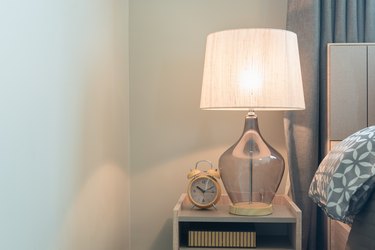
In This Article
When lights start to dim and then get brighter in your house, you should address the situation as soon as possible. Potential reasons for lights dimming in the house and then brightening are typically an overloaded circuit, a loose bulb or a loose connection in the fixture, or what is referred to as an open neutral (a potentially dangerous situation where the electrical load is unbalanced).
If lights are dimming in one room only, that usually means you have a circuit overload, and that's fairly easy to fix, but things get more complicated if the lights are flickering and dimming in the entire house.
Video of the Day
Video of the Day
Here are the causes of dimming lights — and what your next steps should be.
1. An Open Neutral
The lights in the house get brighter or dimmer according to the balance of loads between the red and black legs. When the load on one leg is greater than another, the voltage drop causes lights to dim. At the same time, the lights on one leg get brighter than they should because the effective voltage is greater than 120 volts.
The load balance changes when you turn lights or appliances on or off. That's why you may see that a light starts dim and then gets brighter. This is what's called an open neutral. An open neutral is an unsafe situation that you need to correct as soon as possible.
If you suspect that your electrical problem is an open neutral, here's what you need to do:
- Call the neighbors or post on your neighborhood social media group. Check with one or two neighbors. If they're experiencing the same symptoms as you are, the problem is almost certainly in the power lines, and you should call the power company.
- If their electricity is normal, it's more likely that the disconnection is inside your house, and you need an electrician.
2. Loose Bulb or a Loose Connection in the Fixture
Sometimes lights flicker and dim because of a loose bulb or a loose connection in the fixture. If the flickering is isolated to a single fixture, it's usually a straightforward repair. Tighten the bulb and/or turn off the breaker, check the wire connections to the fixture and tighten those connections.
If all the lights controlled by a switch are flickering, the problem is in the switch, and that's usually also an easy repair. Tighten the connections or replace the switch.
Lights in an entire room can flicker for the same reason that they go dim. They're on the same circuit as a large appliance, and the extra power drawn by the appliance when it cycles on causes voltage fluctuations. The remedy is the same as it is for dimming lights: Move the appliance to a different circuit.
3. Overload in the Circuit
When lights on a single circuit are dimming but everything else in the house is working normally, that's usually a sign of an overload in that circuit. The most common scenario is that a large appliance, such as a refrigerator, shares the circuit with the lights. Every time the appliance cycles on, it draws more power than it does when it's running, and the resultant drop in power dims the lights.
An overloaded circuit isn't dangerous, but it becomes troublesome when the current draw exceeds the rating of the circuit breaker and the breaker trips. If this happens repeatedly, you need to do something.
The most effective fix is to add a new circuit for the appliance, which, if it's a refrigerator, should be on a dedicated circuit anyway. If you live in an older house, the panel may be too small for a new circuit. Upgrading the panel is an expensive proposition, so the alternative is to move the appliance so you can plug it into a less-used circuit.
Electrical Safety Tips
Electricity is dangerous, which is why it's important to call a licensed electrician to troubleshoot problems with the service panel. It's never safe for inexperienced people to work in the panel because the hot bus bars are always energized, even when the main breaker is off. It's doubly hazardous to attempt to diagnose and repair the service lugs themselves.
If you have a reasonable understanding of electrical repair techniques, and you remember to turn off the breaker before starting any work, you can repair individual fixtures and switches yourself. Always check each wire and each connection terminal with a voltmeter to make sure it's dead before you touch it.
It's important that you repair flickering lights as soon as possible. The flickering is a sign of a bad connection that may begin arcing at any time and could start a fire. If you can't correct the problem by tightening the bulb and you're not confident working with electricity, don't hesitate to call an electrician for help.